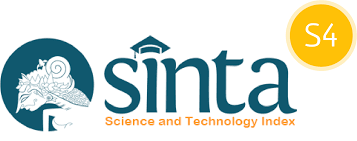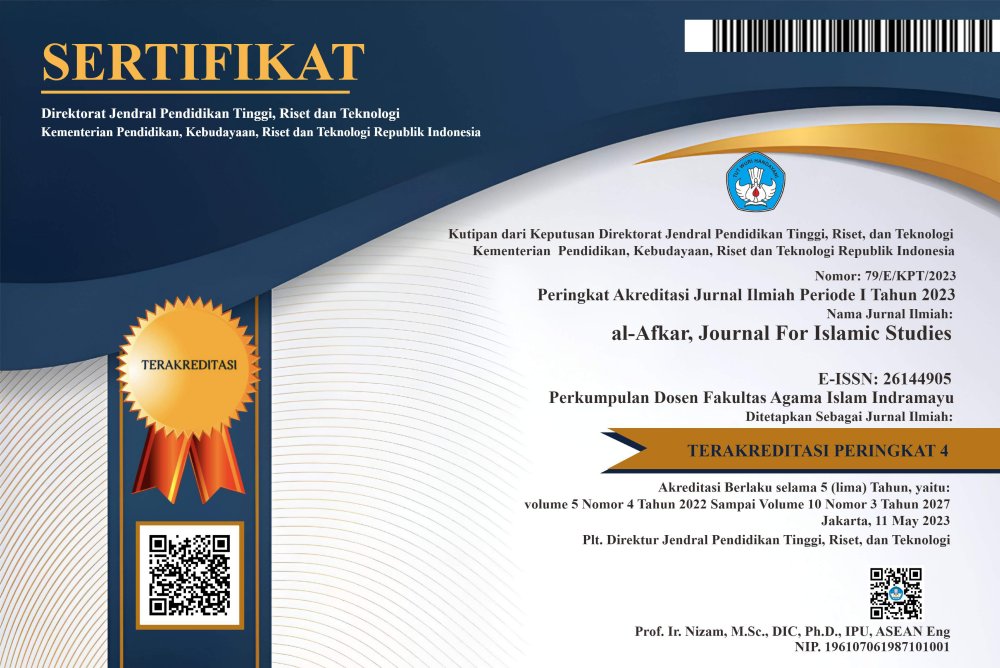Harmonizing Faith: Exploring the Uniformity of Jum’at Sermons in Malaysia (A Study Analysis of Religious Discourse Dynamics)
DOI:
https://doi.org/10.31943/afkarjournal.v7i2.1137Keywords:
Friday sermons, Malaysia, religion, power dynamics.Abstract
This abstract aims to elucidate the phenomenon of Friday sermon uniformity in Malaysia, revealing its intricate relationship with religion and power. Employing a qualitative approach, this study utilizes interviews and document analysis to uncover the mechanisms behind sermon uniformity. It is found that this practice, rooted in the Malaysian Islamization Program, has evolved into a national discourse, serving as a conduit for government messaging and propaganda. Furthermore, the study illuminates the role of religious authorities, particularly within the monarchy, in shaping and enforcing sermon uniformity. It underscores how the convergence of religious and political agendas is reflected through standardized sermon content, emphasizing the influence wielded by these authorities in upholding religious and cultural norms. Through its findings, this research provides valuable insights into the complex power dynamics within Malaysia's religious landscape, prompting further reflection on the implications of such uniformity in a diverse and democratic society.
Downloads
References
Albayrak, I. 2012. “Friday Sermons and the Question of Home-trained Imams in Australia.” Australian eJournal of Theology 19 (1)
Allen, J .de V., The Malayan Union, New Heaven, Yale: University Southeast Asia Studies, 1967
Ascarya dan Diana Yumanita, Bank Syari’ah: Gambaran Umum, (Jakarta, Pustaka Pendidikan dan Studi Bank Kesentralan PPSK, 2005)
Aslan. (2019). Sejarah Perjalanan Kurikulum Pendidikan Islam di Malaysia. Ta’limuna, 8(1), 29–45.
Antoun, R. T. 1993. “Themes and Symbols in the Religious Lesson: A Jordanian Case Study.” International Journal of Middle East Studies 25 (4)
Azodanloo, H. G. 1992. “Formalization of Friday Sermons and Consolidation of the Islamic Republic of Iran.” Critique: Critical Middle Eastern Studies 1 (1)
Borthwick, B. M. 1967. “The Islamic Sermon as a Channel of Political Communication.” Middle East Journal 21 (3)
Camilleri, R. 2013. “Religious Pluralism in Malaysia: The Journey of Three Prime Ministers.” Islam and Christian–Muslim Relations 24 (2)
Crouch, H. (1996). Government and Society in Malaysia. Ithaca: Cornell University Press
Diane K. Mauzy and R. S. Milne, The Mahathir Administration in Malaysia: Discipline through Islam, Pacific Affairs, University of British Columbia, Vol. 56, No. 4, 1984
Drakeley, S. (2008). Drowning or Waving? Citizenship, Multiculturalism and Islam In Malaysia. Aljami’ah, 46(2), 325–351.
El Shamsy, A. 2008. “The Social Construction of Orthodoxy.” In The Cambridge Companion to Classical Islamic Theology, edited by T. Winter, 97–117. Cambridge: Cambridge University Press
Errihani, M. 2011. “Managing Religious Discourse in the Mosque: The End of Extremist Rhetoric during the Friday Sermon.” Journal of North African Studies 16 (3)
Fathi, A. 1981. “The Islamic Pulpit as a Medium of Political Communication.” Journal for the Scientific Study of Religion 20 (2)
Fink, S. 2007. “Preaching as Reimagining: Post-9/11 Khutbahs in the United States and Canada.” Comparative Islamic Studies 3 (2)
Funston, J. 2014. “Malaysia.” In The Politics of Islamic Reassertion, edited by M. Ayoob, 165–189. Hoboken, NJ: Taylor and Francis
Hamid, A. F. A. (2009). Islamist Civil Society Activism In Malaysia Under Abdullah Badawi: The Angkatan Belia Islam Malaysia (ABIM) and The Darul Arwam. Studia Islamika, 16(3), 493–470.
Hashem, M. 2010. “The Ummah in the Khutba: A Religious Sermon or a Civil Discourse?” Journal of Muslim Minority Affairs 30 (1)
Hassan, M. H. 2007. “Explaining Islam’s Special Position and the Politic of Islam in Malaysia.” The Muslim World 97 (2)
Hirschman, C. (1986). The Making of Race in Colonial Malaya: Political Economy and Racial Ideology. Sociological Forum, 1
Hooker, M. B. 2008. Indonesian Syariah: Defining a National School of Islamic Law. Singapore: Institute of Southeast Asian Studies
Jais. 2010b. “E-masjid: Borang Aduan Khutbah Jumaat Jais.” Accessed January 10, 2015. http://emasjid.jais.gov.my/uploads/borangs/KomenKhutbahJumaat.pdf
Jones, L. G. 2012. The Power of Oratory in the Medieval Muslim World. New York: Cambridge University Press
Kamp, M. 2008. “Prayer Leader, Counsellor, Teacher, Social Worker, and Public Relations Officer: On the Roles and Functions of Imams in Germany.” Islam and Muslims in Germany, edited by A. al-Hamarneh and J. Thielmann, 133– 160. Leiden: Brill
Lopez, C. (2001). The British Presence in the Malay World: A Meeting of Civilizational Traditions. Sari, 19
Martin, R. 2004. Encyclopedia of Islam and the Muslim World. New York: Macmillan Reference.
Means, G. P. (1978). Public Policy Toward Religion in Malaysia. Pacific Affairs, 51
Metzger, L. (1998). Islam Observed: The Case of Contemporary Malaysia. Studia Islamika, 5(2), 49–76.
Mohd, S. (2010). Ethnic Identity Dilemma – A Case Study of the Indian Muslims in Penang, Malaysia. International Review of Business Research Papers, 6
Muhammad, M. R. 2009. “IT Alignment in Malaysian Public Sector: e-Syariah as a Case of Study.” In Proceedings of the European Conference on EGovernment, edited by P. Hahamis, 501–509. London: University of Westminster
Muzakki, A. 2008. “Islam as a Symbolic Commodity: Transmitting and Consuming Islam through Public Sermons in Indonesia.” In Religious Commodifications in Asia: Marketing Gods, edited by P. Kitiarsa, 205–219. New York: Routledge.
Nagata, J. (1984). The Reflowering of Malaysian Islam: Modern Religious Radicals and Their Roots. Toronto: University of British Columbia Press
Nawab, M., & Osman, M. (2009). Hizbut Tahrir Malaysia: The Emergence of a New Transnational Islamist Movement in Malaysia. Aljami’ah, 47(1), 91–110.
Nurhasanah. (2011). Tabung Haji Malaysia Dalam Perspektif Ekonomi. Al-Iqtishad, III(2), 179–192.
Reeber, M. 1991. “A Study of Islamic Preaching in France.” Islam and Christian– Muslim Relations 2 (2)
Saat, N. (2014). The Ulama, Thought-Styles, and The Islamic State Debate In Contemporary Malaysia. Stu, 21(1), 47–76.
Sharma, Western Political Thoought, (Plato to Hugo Grotius), New Delhi: Sterling Private Limited, 1982
Shamsul, A. B. (1997). Identity Construction, Nation Formation, and Islamic Revivalism in Malaysia. In R. Hefner & P. Horvatich (Eds.), Islam in an Era of Nation-States: Politics and Religious Renewal in Muslim Southeast Asia. Honolulu: University of Hawaii Press
Shiozaki, Y. (2015). The Historical Origins of Control Over Deviant Groups In Malaysia: Official Fatwa and Regulation of Interpretation. Studia Islamika, 22(2), 205–232.
Simon C. Smith, British Relations with the Malay Rulers From Decentralization to Malayan Independence 1930-1957, New York: Oxford University Press, 1995
Wan Mohd Saman, Wan Satirah, and Abrar Haider. 2013. "E-Shariah in Malaysia: Technology adoption within justice system." Transforming Government: People, Process and Policy 7.2
Wardak, A. 2002. “The Mosque and Social Control in Edinburgh's Muslim Community.” Culture and Religion 3 (2)
Wiktorowicz, Q. 1999. “State Power and the Regulation of Islam in Jordan.” Journal of Church and State 41 (4)
Wiktorowicz, Q. 2001. The Management of Islamic Activism: Salafis, the Muslim Brotherhood, and State Power in Jordan. Albany: State University of New York Press
Yeoh, C. R. (2006). Malaysia, Truly Asia? Religious Pluralism in Malaysia. The Pluralism Project. Cambridge: Harvard University Press
Downloads
Published
How to Cite
Issue
Section
License
Copyright (c) 2024 Abdul Matin Bin Salman, Fuad Muhammad Zein, Joko Robby Prasetyo

This work is licensed under a Creative Commons Attribution 4.0 International License.



















